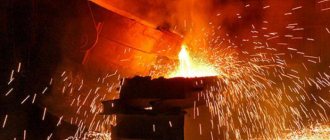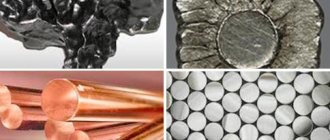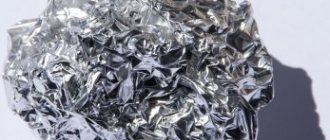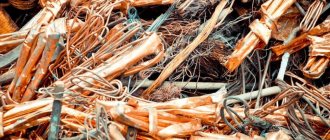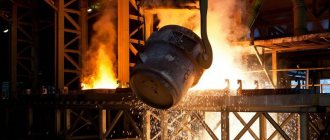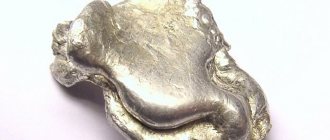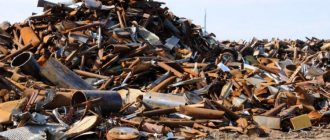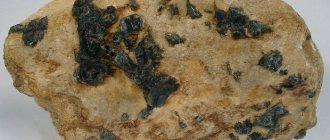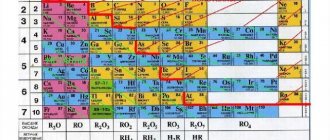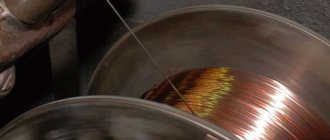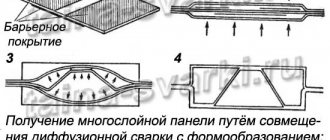What is considered non-ferrous metal?
The first level of division of metals is into ferrous and non-ferrous.
There are no problems with black ones: these are iron and its alloys (cast iron, steel).
People of color are ranked differently. Sometimes all metals except iron and its alloys are considered as such (the list includes noble, rare earth, radioactive).
Industrialists have their own classification. Non-ferrous metals are iron-free elements of a certain color shade (hence the name of the group).
Divided into two types:
- Heavy - zinc, copper, tin, lead, nickel.
- Lightweight – aluminum, magnesium, titanium.
In a number of countries, such metals are called non-ferrous rather than non-ferrous.
The abbreviated name of the segment of non-ferrous metals is non- ferrous metal , ferrous metals - ferrous metal .
Iron ores
In its pure form, this element of the periodic table is found in fairly small quantities in the earth's crust (only 5.5%). But there is a lot of it in various iron ores.
The most significant deposits (reserves amount to more than 30 trillion tons) are layers of ferruginous quartzites, which are more than two billion years old. They are distributed mainly in places such as South and North America, Africa, India and western Australia.
Ferrous metal and non-ferrous metal: what is the difference?
The first factor by which non-ferrous metals differ from ferrous metals is the lack of magnetism. In ferrous metal, it is created by iron.
To distinguish ferrous metal from non-ferrous metal, a magnet is brought to the sample. If it is attracted, it is made of black metal .
Other characteristics of non-ferrous metal:
- More flexible, lighter than black ones.
- Due to the absence of iron, non-ferrous metal is more resistant to corrosion.
- Premium mechanical performance at low temperatures. However, copper, aluminum, and magnesium lose them when heated, collapsing even from a slight blow.
- They interact with gases (excluding inert ones), dissolving them when heated.
- High thermal conductivity, heat capacity. This property of non-ferrous metal is taken into account by welders. Operation requires a thermal pulse, without which the product quickly cools down. Therefore, before welding, parts (especially those made of aluminum, copper, magnesium) are heated.
- Stronger, more durable. Invulnerability to external force majeure is ensured by an oxide film on the surface.
However, aggressive external factors (especially an oxygen-humid environment) affect the structure of non-ferrous metal. For example, galvanized surfaces become whitish.
In non-ferrous metal, only the surface is oxidized, unlike ferrous metals.
Features of the delivery of heavy metals
In any city in Russia, non-ferrous metal can be handed over to special points. Each point operates on the basis of admission rules, which are not too different from each other. The main features include the following nuances:
- Only grouped metals, one lot at a time, are accepted.
- The classification of a heavy metal is carried out according to its external characteristics; a specialist also examines the markings and, if necessary, conducts a chemical analysis.
- Delivery is carried out by net weight.
- Any metal in large quantities is accepted only on the basis of documents confirming that it is owned.
- Metal should not be included in the list of materials prohibited by the laws of the Russian Federation.
Extraction and processing
The source of non-ferrous metal is ore raw materials. The methods of extracting ore are traditional: from a mine or quarry.
Non-ferrous metallurgy deals with raw materials. This is a full cycle segment.
The following processes are performed here:
- Enrichment (purification of non-ferrous metal ores from impurities).
- Fuse.
- Mechanical restoration. The material is forged, pressed, stamped.
A distinction is made between metallurgy of light and heavy metals. In both forms, it is a costly, polluting production.
The second way to obtain raw materials is by recycling scrap metal. A more cost-effective, environmentally friendly method.
Based on their origin, a distinction is made between primary (from ore) and secondary (from scrap) metal.
History of non-ferrous metallurgy
Non-ferrous metals today are actively used in mechanical engineering, the chemical industry, construction and many other areas of production. Thanks to scientific and technological progress, the scope of application of this material is constantly expanding, and metal extraction technologies continue to improve.
Over time, the use of non-ferrous metals increased, which led to the discovery of new elements and names. More and more metals began to be used in production. At the beginning of the 20th century, about 15 names were used, and after 50 years - twice as many. Today, more than 70 different metals are used, which is the majority of those currently known.
The increase in the level of demand for heavy non-ferrous metals was due to the growing needs of the military industry (for the production of ammunition), but the light group was used in the aerospace industry.
Since ancient times, the noble group has been massively used for the manufacture of jewelry and ornaments. In the 90s of the 20th century, 78% of gold, 36% of platinum and 15% of silver were used precisely for these purposes. If we take other areas where noble non-ferrous metals are used, they are electronic production (gold contacts in devices), automobile production (about 43% platinum), and silver was used to make film and photographic materials.
Classification and scope of application of non-ferrous metal
Based on their physical properties, non-ferrous metals are divided into heavy and light metals. The scope of use of both types is determined by the properties of non-ferrous metals: wear resistance, lightness against the background of strength, ductility, corrosion resistance.
Heavy non-ferrous metals
This type of non-ferrous metal includes five names.
Copper
Number one in non-ferrous metal. The most common plus is increased plasticity, thermal and electrical conductivity. Forms alloys with almost all metals. The most popular are bronze (with tin), brass (with zinc), and red gold.
Native copper
Golden-colored non-ferrous metal with a pinkish tint is the basis of cables, wires, pipes for thermal units, ammunition, household products, and decor.
Lead
The heaviest of the non-ferrous metals, dense bluish-gray.
Soft (1.5 out of 10 Mohs), cut by hand, scratchable with a fingernail, easily rolled to foil.
Thermal and electrical conductivity is below average: copper, for example, is an order of magnitude higher. Plus, low resistance to vibrations, vulnerability to rotting organic matter, solutions of lime, and concrete.
Used for batteries, base and coating of wires, cables, electrodes, ammunition.
Lead provides a radiation shield, but is toxic, classified as a chemically hazardous substance of class 1.
Zinc
A low-melting non-ferrous metal with changeable properties: brittle at normal temperatures, plastic when heated. Indifferent to rust, destroyed by acids or alkalis.
Used by machine builders and metallurgists as a coating for iron to prevent corrosion.
Tin
Silvery-white, moderately lustrous heavy metal.
In demand as a component of alloys for bearings and solders.
Molten Tin
The most environmentally friendly non-ferrous metal in the “heavy” segment, therefore it is used not only by industry, but also in everyday life (for example, as a material for lids for preservation).
Nickel
Silvery-white with yellowish tint. One of the best catalysts, an essential component of stainless steels, increasing chemical resistance.
Fine nickel powder spontaneously ignites at room temperature.
In demand by manufacturers of alkaline batteries (including for electric vehicles) and containers for chemically aggressive substances.
Light non-ferrous metals
The light non-ferrous metals segment consists of three positions.
Aluminum
Silver nonferrous metal is a superconductor of electricity and is plastic. Mechanical parameters leave much to be desired, so it is added to alloys. They are durable, lightweight, resistant to corrosion, most aggressive environments, and thermal influences.
It is used as a body material for aircraft and sea vessels, and electrical wires.
Titanium
Shiny silver material with a bluish tint. Lightweight, durable, corrosion resistant, tough. Plastic, becomes brittle at -80°C or a large percentage of impurities.
Rod composed of high purity titanium crystals
The strength of non-ferrous metal is comparable to that of steel, but it is half lighter. Twice as strong as aluminum, but only half as massive. For this it is valued by builders of rockets, aircraft, ships, and oil workers.
Preparation of a titanium frame for an F-15 fighter before and after pressing on an Alcoa stamping press with a force of 45 thousand tons, May 1985
Titanium is compatible with the tissues of the human body, due to which it is used by the food industry and as a material for exoskeletons, dentures, and piercings.
Magnesium
Light, beautiful shiny substance.
Due to its low density, non-ferrous metal is easy to process and is resistant to heat and most flammable substances.
Magnesium metal
However, it requires caution. In heated air it burns with a bright glow. A mixture of powder with potassium permanganate and other oxidizing agents causes an explosion.
It is impossible to extinguish burning magnesium with water.
Groups
Scientists divide non-ferrous metals into several groups:
- Heavy.
Tin, copper, nickel, zinc, lead, etc. Extracted from sulfide and oxidized polymetallic ores. World production of metals in this category reaches several million tons per year. - Lungs.
Aluminum, titanium, magnesium, sodium, potassium, calcium, beryllium, strontium, barium and other elements in this group have the lowest specific gravity among other non-ferrous metals. - Noble.
Gold, silver, platinum, ruthenium, rhodium, palladium, osmium and iridium are among the rare precious metals and are characterized by increased resistance to oxidation and corrosion. - Small ones.
Representatives of the group are mercury, cobalt, arsenic, antimony, bismuth, etc. Mined in small quantities along with heavy metals. - Refractory.
Known as the most wear-resistant metals. These include zirconium, vanadium, chromium, tungsten, molybdenum and other elements with high density and melting point. - Rare earths.
Represented by 17 silver-white metals: holmium, thulium, scandium, samarium, europium, dysprosium, lutetium, promethium, etc. They have the same chemical properties. - Absent-minded.
Rubidium, thallium, gallium, indium, scandium, germanium, rhenium, hafnium, selenium, etc. They are not found in nature as individual elements. Extracted from minerals and ores of other metals. - Radioactive.
Uranium, thorium, protactinium, radium, actinium, neptunium, plutonium, americium, californium, einsteinium, fermium, mendelevium and other elements obtained as a result of nuclear reactions. Such metals emit neutrons, protons, alpha and beta particles or gamma quanta.
Recycling of non-ferrous metal
Used non-ferrous metal is not disposed of for many reasons.
Recycling is profitable
Primary production of non-ferrous metal (from ores) is a costly, labor-intensive, environmentally problematic process. Therefore, it is natural for enterprises to strive to optimize costs. That is, to recycle non-ferrous scrap metal. The cost of the process is five times cheaper than processing primary raw materials.
Recycling non-ferrous metal scrap is beneficial: the company saves money while avoiding fines for environmental pollution.
Non-ferrous metal distributors also receive good money. Therefore, industrial enterprises have developed the practice of storing such scrap metal for delivery to a collection point or metallurgical plant.
What kind of scrap is taken for recycling?
Scrap metal is divided into two types:
- Household – housing, parts of used household appliances, gadgets, cables.
- Industrial – equipment that cannot be repaired, worn-out structural elements, shavings, other waste, production rejection.
Aluminum, copper, nickel, lead, zinc, tin, and titanium scrap are suitable for processing. Plus alloys (bronze, brass), mixed scrap.
Nickel
Compared to other heavy non-ferrous metals, nickel is the most durable, hard, refractory and resistant to corrosion. Like iron and cobalt, it is ferromagnetic. Pure nickel is ductile and easy to process.
Nickel is relatively expensive, and its consumption in pure form is low. To protect against corrosion and for decorative purposes, products made of iron, aluminum, magnesium, zinc and other metals are coated with a thin layer of nickel (nickel plating). In the form of sheets, pipes, and wire, it is used for special products for chemical production - parts of equipment and devices.
Nickel is also required for the production of alkaline batteries - iron-nickel and nickel-cadmium. These batteries are lighter, more compact and more reliable in operation than lead batteries. Nickel catalysts are used in many chemical technology industries.
More than half of all nickel is consumed in alloys with iron. Chromium-nickel, stainless and acid-resistant steels, usually containing up to 8% nickel, chromium and other metals, are widely used in the chemical industry and machine tool industry, as well as for the construction of durable structures, mechanical engineering and military equipment. Strong and wear-resistant nickel cast irons containing chromium, molybdenum and copper are needed for the production of powerful internal combustion engines for locomotives, special machines and dies.
Many nickel alloys are heat-resistant: they do not oxidize in air at high temperatures. These include alloys EI, Inconel, Nimonic, Gastelloy, etc., capable of operating at temperatures up to 600 °C. They are used for the production of jet turbines, gas turbine units and in nuclear reactors.
Nichrome (75–85% Ni, 10–20% Cr, the rest iron) and other similar thermoelectric nickel alloys are not only heat-resistant, but also have high ohmic resistance and are used for wire or tape heaters.
A highly magnetic alloy of nickel with iron (permalloy) and other alloys similar to it are used in electrical engineering and radio engineering.
Of the alloys of nickel with non-ferrous metals, copper-nickel alloys are the most important; they have already been discussed above.
The first metallic nickel was obtained in Sweden in 1751, and its production for sale began only in 1825. For a long time it remained insignificant. Many of the valuable properties of nickel were not known until the beginning of the 20th century, so it was only in the 20th century that the demand for this metal began to grow rapidly.
Now nickel consumption in all countries is strictly taken into account and measures are taken to use it economically. To achieve this, more and more of the nickel in stainless steels is being replaced by chromium, and conventional steels are being coated with a thin layer of stainless steel (cladding).
Aluminum
Refers to light metals. It has a silvery color and a melting point of about seven hundred degrees. In industrial conditions it is used in alloys. It is used wherever metal is needed. Aluminum has low density and high strength. This metal is easy to cut, saw, weld, drill, solder and bend.
Alloys are formed with metals of various properties, such as copper, nickel, magnesium, silicon. They are highly durable and do not rust in adverse weather conditions. Aluminum has high electrical and thermal conductivity.
Lead
Lead has been known since ancient times - at least two millennia BC. e. At that time, the easy machinability of soft lead and its high density were especially valued. Coins, jewelry, various vessels, water pipes, projectiles for slings and catapults were made from lead. With the invention of gunpowder, lead was used to make buckshot, bullets and shot.
Read also: Flux for soldering batteries
Lead's resistance to dilute sulfuric and hydrochloric acids and many other reagents made this metal a popular choice in the 19th century. the main material of the then emerging chemical industry. Lead is easily rolled. Sheet (rolled) lead with a thickness of 2 to 10 mm is convenient for covering equipment and protecting it from corrosion.
The sheaths of cables intended for long-term operation underground, in water or in a humid atmosphere are now made from lead, adding small amounts of other metals to it for greater ductility.
Lead-acid batteries are still needed to ignite internal combustion engines, despite the advent of nickel batteries, which are significantly more expensive. About half of all lead is spent on the production of cables and batteries.
In nuclear technology, lead serves as protection against γ rays, which it absorbs better than many other materials.
In military affairs, lead is still needed for the manufacture of shrapnel and core bullets.
Lead alloys differ from pure metal either in greater strength and hardness, or in anti-friction; Most of them are also resistant to corrosion.
Alloys with a low coefficient of friction - babbitts (after the name of the inventor Babbitt) - are divided into tin-bearing and tin-free. The former contain, in addition to lead, tin, copper, antimony, cadmium, nickel and tellurium, and the latter contain sodium, calcium, tellurium and other elements. Babbitts are low-melting, they are poured in liquid form into bearing shells or applied as a layer on a steel strip.
Typographic alloys for casting fonts contain, in addition to lead, antimony, tin and copper. Antimony gives them hardness, and tin gives them casting qualities.
In the chemical industry, alloys of lead and antimony are often used - they are hard and resistant to corrosion.
In alloys for soldering - solders, lead is partially replaced by more expensive and scarce tin.
Demand for lead constantly outstrips its production. Therefore, in modern industry, new ways to save lead are being outlined. They are now trying to replace the lead sheaths of some cables with plastic ones, and anti-corrosion coatings with synthetic organic materials. Printing lead alloys can sometimes be replaced with zinc alloys, and in the future - with plastics, when plastics with good casting properties are obtained.
Information about the history of the development of zinc production is varied. According to some of them, this metal was produced in India and China back in the 5th century. Industrial production of zinc in Europe arose only in the 18th century. in England, then in Upper Silesia.
Currently, about half of the zinc produced is used to coat iron to protect it from corrosion. A thin layer of zinc is applied to the iron using a hot method or electrolysis. The electrolytic coating is thinner and zinc is consumed more economically; however, due to more complex equipment, hot-dip galvanizing is still used more often than electrolysis. Zinc reliably protects iron from corrosion in air and cold water. Galvanizing is much cheaper than coating with tin - tinning or nickel - nickel plating.
Another important area of zinc consumption is the production of alloys, including the already familiar brass and nickel silver.
Zinc-based alloys partially replace bronze and babbitt in bearings. These zinc alloys contain 8–11% aluminum, 1–2% copper, and 0.03–0.06% magnesium. The same components, but in different proportions with zinc, are contained in typographic alloys, similar in properties to lead-antimony alloys.
Compared to other non-ferrous metals, zinc is cheap, and its resources in known deposits are quite large. Therefore, the problem of replacing zinc with other metals did not arise. With the increase in aluminum production and a decrease in its cost, it may be advantageous to coat iron not with zinc, but with aluminum - aluminizing.
Titanium
This is a light metal. It is not magnetic. It has a silver color with a bluish tint. It has high strength and corrosion resistance. But titanium has low electrical and thermal conductivity. Loses mechanical properties at a temperature of 400 degrees, becomes brittle at 540 degrees.
The mechanical properties of titanium are enhanced in alloys with molybdenum, manganese, aluminum, chromium and others. Depending on the alloying metal, alloys have different strengths, including high-strength ones. Such alloys are used in aircraft construction, mechanical engineering, and shipbuilding. They are used to produce rocketry, household appliances and much more.
Lead salts are a danger to nature and humans
As mentioned, lead is a heavy metal that is dangerous to internal organs. It affects the brain, liver and musculoskeletal system. Lead salts have the ability to accumulate in human bone tissue. To identify them in the body, a blood test is done.
Lead salts have a particularly strong effect on preschool children. The absorption of metal into their body is 4-5 times higher than into the body of a mature person. Accumulated lead has a detrimental effect on pregnancy, causing irreparable harm to the fetus. It affects intellectual abilities, the ability to concentrate, and absorb knowledge.
The safe proportion of lead salts in the blood has not been established. However, it has been proven that as their exposure increases, the severity of the signs of poisoning increases. The developmental deviations described above can be caused by even the smallest content of the element - 5 mcg/dl.
Copper
Non-ferrous metals, the list of which is presented above, are not all used in industry. In this case we are talking about a common heavy metal – copper. It has high thermal conductivity, electrical conductivity and ductility.
Copper alloys are widely used in industries such as mechanical engineering, and all due to the fact that this heavy metal is well alloyed with others.
The importance of recycling
As you can see, lead is a difficult element in the periodic table. It can be both useful and dangerous for humans, because it causes poisoning. To reduce uncontrolled spread throughout the world, it is recommended to collect it for recycling.
The production of products from recycled metal reduces environmental pollution and the risk to humans. There are ways to clean the element from other substances that were produced during operation and recycle it.
In Moscow and other cities of Russia, collection points have been opened that actively buy products containing lead from the population. Mainly batteries and cables.
By transferring metal for further production, a person helps not only himself, but also future generations. It is highly undesirable to take products containing lead salts to a landfill. The metal easily penetrates soil and water. When burned (and fires often occur in landfills), lead releases toxic fumes into the air. That is why it is strongly recommended to contact metal collection points and hand over lead for processing and further production. Today, the average price for 1 kg of an element is from 75 rubles.
